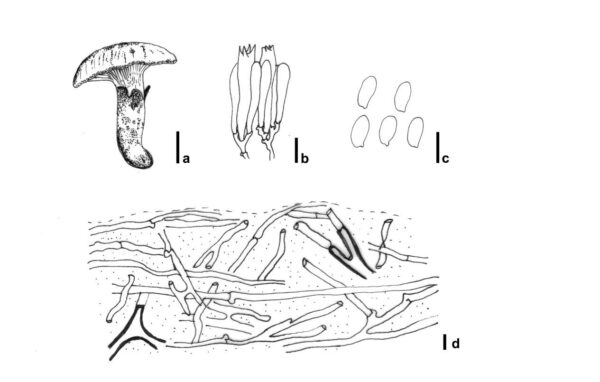Fungalpedia – Note 347, Catathelasma
Catathelasma Lovejoy.
Citation if using this entry: Khyaju et al. 2025 (in prep.) – Fungalpedia, Basidiomycota 4.
Index Fungorum, FaceofFungi, Mycobank, GenBank, Fig. 1
Classification: Biannulariaceae, Agaricales, Agaricomycetidae, Agaricomycetes, Agaricomycotina, Basidiomycota, Fungi
Catathelasma was established by Ruth Harrison Lovejoy with Catathelasma evanescens as the type species (Lovejoy 1910, Ge et al. 2020). Species of Catathelasma are known to be ectomycorrhizal (Trappe 1962, Tedersoo & Smith 2013, Ge et al. 2020). Catathelasma was initially classified under Tricholomataceae and later reclassified into Biannulariaceae (Singer 1975, Jülich 1982, Singer 1986, Ge et al. 2020). The type specimen was collected from open balsam and spruce woods occurring singly in sod on thick humus in Wyoming, United States of America (Lovejoy 1910). The Global Biodiversity Information Facility (2024) indicates the distribution of species in the northern hemisphere of Catathelasma. Basidiomata are characterized by distinct tricholomatoid morphology, featuring decurrent to adnate to sinuate-adnexed lamellae, a double annulus, bilateral to subregular lamella trama, and a firm, white context (Lovejoy 1910, Ge et al. 2020). The pileus is somewhat fleshy, initially convex, and then expands (Lovejoy 1910, Ge et al. 2020). Basidiospores are white, oblong, smooth, amyloid, and acyanophilic (Ge et al. 2020). Clamp connections are present (Ge et al. 2020).
Species within Catathelasma were delineated using morphological characteristics, phylogenetic evidence (combined ITS, LSU, tef1), host preferences, and geographic distribution (Ge et al. 2020). Ge et al. (2020) revealed the presence of two monophyletic clades within Catathelasma, namely the imperiale clade and the subalpinum clade. Catathelasma forms a sister clade with Cleistocybe (Ammirati et al. 2007). However, Cleistocybe has not been reported as ectomycorrhizal and is characterised by inamyloid basidiospores and a partial veil (Ammirati et al. 2007). Index Fungorum (2024) has reported six species within Catathelasma. The edible mushroom Catathelasma ventricosum has been reported to possess antidiabetic, antihyperglycemic, antihyperlipidemic, antibacterial, and antioxidant activities (Liu et al. 2013, Liu et al. 2016, Liu et al. 2017).
Synonymy: Biannularia Beck
Type species: Catathelasma evanescens Lovejoy
Other accepted species: Catathelasma imperiale (P. Karst.) Singer
Catathelasma laorentou Z.W. Ge
Catathelasma singeri Mitchel & A.H. Sm.
Catathelasma subalpinum Z.W. Ge
Catathelasma ventricosum (Peck) Singer
Figure 1 − Catathelasma laorentou (a = HKAS 92245, b−d = HKAS 105984). a Basidiomata. b Basidia. c Basidiospores. d Pileipellis, oleiferous hyphae are indicated by thick-walled hyphae. Scale bar: a = 2.5 cm, b –d = 10 µm. Redrawn from Ge et al. (2020).
References
Ammirati JF, Parker AD, Matheny PB 2007 − Cleistocybe, a new genus of Agaricales. Mycoscience, 48(5), 282−289.
Ge ZW, Wu JY, Hao YJ, Zhang Q et al. 2020 − The genus Catathelasma (Catathelasmataceae, Basidiomycota) in China. MycoKeys, 62, 123.
Julich W 1982 − Higher taxa of Basidiomycetes. Bibliotheca Mycologica, 85.
Liu Y, Chen D, You Y, Zeng S et al. 2016 − Structural characterization and antidiabetic activity of a glucopyranose-rich heteropolysaccharide from Catathelasma ventricosum. Carbohydrate polymers, 149, 399−407.
Liu Y, Sun J, Rao S, Su Y et al. 2013 − Antihyperglycemic, antihyperlipidemic and antioxidant activities of polysaccharides from Catathelasma ventricosum in streptozotocin-induced diabetic mice. Food and Chemical Toxicology, 57, 39−45.
Liu Y, You Y, Li Y, Zhang L et al. 2017 − Characterization of carboxymethylated polysaccharides from Catathelasma ventricosum and their antioxidant and antibacterial activities. Journal of functional foods, 38, 355−362.
Singer R 1975 − The Agaricales in modern taxonomy. 3rd edition. Cramer, Vaduz, 912.
Singer R 1986 − The Agaricales in modern taxonomy, 4th edition, Koeltz Scientific Books, Koenigstein, 981.
Trappe JM 1962 − Fungus associates of ectotrophic mycorrhizae. The Botanical Review, 28(4), 538−606.
Entry by:
Sabin Khyaju, Center of Excellence in Fungal Research, School of Science, Mae Fah Luang University, Chiang Rai, Thailand
(Edited by Thatsanee Luangharn, Samaneh Chaharmiri-Dokhaharani, Achala R. Rathnayaka)
Published online 27 August 2024
